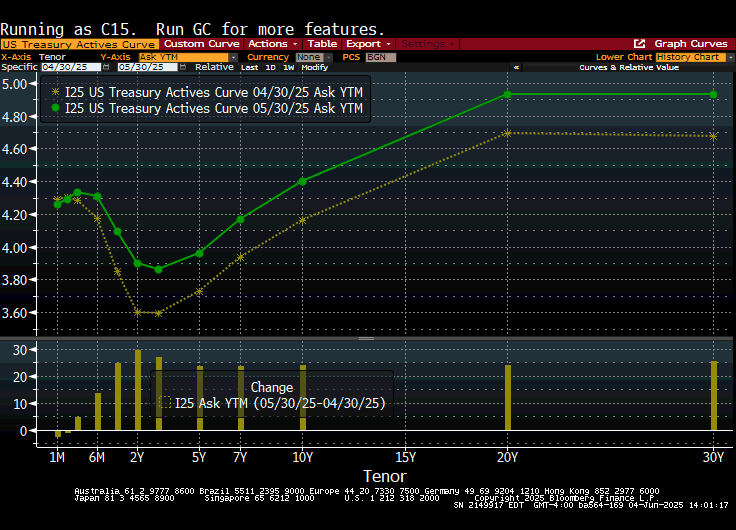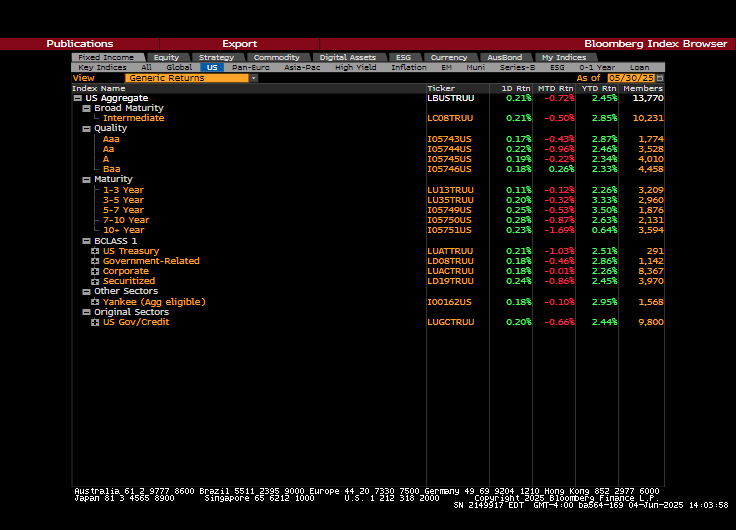May 2025 Monthly Commentary
- Piton Investment Management
- Jun 5
- 7 min read
Updated: Sep 4

MARKET OVERVIEW:
May was marked by a strong rebound in U.S. markets as easing trade tensions and resilient economic indicators boosted investor sentiment. Early in the month, the U.S. and China agreed to de-escalate their trade war – including a 90-day suspension of planned tariffs – which proved to be a major catalyst for risk assets. This policy pivot, alongside more conciliatory trade talks with other partners (such as India and the EU), alleviated one of the market’s biggest overhangs from April. By the end of May, equity indices had not only recovered their early-April losses but also pushed above levels last seen on the April 2nd “Liberation Day” tariff scare, reflecting a notable swing in market momentum.
Investor behavior shifted accordingly. After flocking to safe havens in March and April, investors rotated back into riskier assets in May. Gold prices, which had climbed for four consecutive months, were flat in May, and the U.S. dollar also held steady – signs that anxiety was ebbing. At the same time, previously beaten-down sectors rallied, and credit markets stabilized. However, sentiment was not uniformly positive. Consumer confidence deteriorated to one of its lowest readings on record (University of Michigan index at 50.8), highlighting that Main Street remained cautious. These contrasting signals underscore an atmosphere of “cautious optimism” – markets are rising, but many remain wary of underlying economic risks.
Policy developments and geopolitics continued to dominate headlines. In Washington, the Federal Reserve held its policy rate steady in early May, as expected, choosing to monitor how the economy evolves amid the trade truce and moderating inflation. Meanwhile, the White House’s actions were a key focus for investors: President Trump’s more pragmatic stance on trade (easing tariffs and seeking negotiated deals) provided relief, but ongoing negotiations and legal challenges kept investors alert. Elsewhere, concerns about fiscal deficits and a potential government funding impasse began to simmer, contributing to a late month uptick in longer-term interest rates.
EQUITY MARKETS PERFORMANCE:
U.S. equities roared back in May, delivering their strongest monthly gains since late 2023. The S&P 500 Index jumped approximately +6.3% (total return) for the month, the Dow Jones Industrial Average rose about +4.2%, and the tech-heavy Nasdaq Composite surged nearly +9.7%. Even small-cap stocks participated, with the Russell 2000 up around +5.3%. This broad rally was fueled in large part by the thaw in U.S.-China trade relations. Market gains were widespread, with 10 of 11 S&P sectors posting positive returns. Technology stocks led the charge – the sector climbed roughly +10.9% in May – powered by robust earnings and investor enthusiasm in areas such as artificial intelligence and semiconductors. Defensive areas generally lagged behind the pack. Healthcare was the sole sector to finish negative – the S&P Healthcare sector slipped about –5.6%, weighed down by underperformance in pharmaceuticals and managed care providers. In sum, equity markets in May were driven by a potent mix of positive policy news, robust corporate performance, and a resurgence of risk appetite after months of turbulence.
FIXED INCOME MARKETS PERFORMANCE:
The fixed income arena experienced a negative turn in May, as improving economic optimism and renewed concerns about inflation pushed U.S. Treasury yields higher across the curve. After rallying in April, Treasuries sold off in May: the benchmark 10-year Treasury yield jumped roughly 24 basis points, ending the month around 4.4%. The 2-year Treasury yield also rose by approximately 0.30% to about 3.9%. (Notably, yields had swung lower in April amid the trade scare, so May’s backup in rates still left short-term yields below their March highs.) This rise in long-term yields outpaced the short end – for example, the 3-month T-bill nudged up only 5 bps – resulting in a steeper yield curve by month’s end. The steepening was driven in part by reduced expectations of immediate Fed rate cuts and by investor concerns about mounting federal deficits and Treasury issuance.
In other words, with the Fed on hold (even hinting at a hawkish bias) and heavy supply on the horizon, the path of least resistance for long-term yields was upward. For bond investors, rising rates translated into mixed performance across fixed income sectors. Treasury prices fell, delivering negative total returns for May – especially on the long end. A popular long-duration Treasury index (TLT) dropped about –3.2% in the month, exemplifying the rate sensitivity of extended maturities. Shorter-duration Treasuries held up better (the 2-year note’s price was nearly flat), but overall, the broad Bloomberg U.S. Aggregate bond index logged a .72% loss for May.
Importantly, credit-sensitive sectors fared relatively better than pure government bonds as risk sentiment improved. Investment grade corporate bond spreads, which had widened sharply during the April volatility, tightened modestly in May amidst a calmer backdrop. This helped investment-grade corporates outperform Treasuries – their price decline was cushioned by higher coupons and narrowing risk premiums. Even so, IG corporate total returns were roughly flat to slightly negative for the month, as the benefit of spread tightening only partly offset the drag from higher benchmark yields. Lower-rated sectors saw a stronger impact from the “risk-on” tone. High-yield bonds and emerging market debt enjoyed small positive returns in May. The securitized portion of the fixed income market had a subdued month. Agency mortgage-backed securities (MBS) saw slightly negative returns, as mortgage rates rose in line with the uptick in Treasury yields. Municipal bonds began to find their footing in late May. After two consecutive monthly declines (February and March) and heavy tax-season outflows in April, tax-free Munis stabilized as May progressed.
Yields on Munis initially mirrored Treasury increases, but by month-end, municipal yields had edged lower (prices up) thanks to a resurgence of demand and lighter new issuance. Intermediate-term Muni indices ended May roughly flat, and the sector’s valuations versus Treasuries became more attractive, drawing bargain hunters. While pockets of the Muni market (e.g. certain high-profile university revenue bonds) still faced pressure – recalling the President’s earlier threats to cut funding to some institutions – the overall outlook improved with the broader risk rally.
In summary, May’s fixed income story was one of rising rates but resilient credit. Treasuries and other rate-sensitive bonds took a hit as yields climbed. Yet spread products (corporates, high yield, EM debt) weathered the month relatively well, supported by investors’ renewed appetite for risk and income.
Going forward, bond traders are watching closely for any sign that the Fed might shift course – either a turn toward easing if growth falters, or a more aggressive tone if inflation re-accelerates – as this will heavily influence yield curve dynamics and credit conditions in the coming months.
KEY ECONOMIC DATA AND TRENDS:
U.S. economic data released or observed in May 2025 painted a picture of slowing growth with gradually easing inflation, as the labor market sent mixed signals and trade remained a wildcard.
GDP and Growth:
The U.S. economy contracted in the first quarter of 2025, with GDP declining – 0.2% (updated) – the first quarterly drop in three years. This downturn was driven largely by a record surge in imports (up ~50% in Q1) ahead of anticipated tariffs, which caused net trade to drag heavily on growth. Consumer spending, by contrast, cooled significantly from its late-2024 pace (amid a post-holiday lull and bad winter weather) but still grew modestly in Q1. Looking ahead, economists warn that Q2 could remain weak – the import bulge is unwinding, and inventory building is likely to slow, removing those temporary supports.
Inflation:
Inflationary pressures showed tentative signs of moderation. Headline consumer inflation (CPI) for April came in slightly lower on a year-over-year basis than the month prior, continuing a downward trend. Both the CPI and the Producer Price Index (PPI) indicated that annual price increases decelerated in the latest data.
Labor Market:
The labor market sent mixed signals in May. On the one hand, weekly jobless claims have been creeping up, and April’s private payroll report (ADP) showed a gain of only ~62,000 jobs – roughly half the anticipated pace. Job openings have also declined from last year’s highs, and anecdotal reports hint at slower hiring in interest-rate-sensitive sectors (like finance and housing). On the other hand, the unemployment rate remained steady at 4.2%, near multi-year lows, indicating that no widespread layoffs have materialized. The official nonfarm payrolls for April still showed employment growth (albeit slower than earlier in 2025), and wage growth has been moderate.
Trade Balance:
The U.S. trade deficit remains a prominent issue. Trade data for March (reported in May) showed the deficit still running at historically wide levels, reflecting that earlier import surge and weaker exports. Net exports subtracted a huge ~4.8 percentage points from Q1 GDP growth. In April and May, with many tariffs on hold and global demand dynamics shifting, there are early signs the trade gap may start to narrow – for instance, port data suggest imports cooled somewhat as the initial stockpiling passed. The tariff truce has provided hope: if negotiations with China and other nations lead to lower trade barriers, export growth could pick up, and imports might normalize, reducing the deficit over time.
Federal Reserve Policy:
The Federal Reserve held its benchmark federal funds rate steady at 4.25– 4.50% at the FOMC meeting on May 7th – marking the third consecutive meeting without a change. Fed Chair Powell and colleagues signaled a patient, data-dependent stance, given the crosscurrents in the economy. With inflation above target but easing and growth slowing but not collapsing, the Fed has adopted a “wait and see” approach. Federal Reserve communications suggest concern about upside inflation risks (should price pressures persist) even as they acknowledge rising recession odds. At the end of May, futures markets were pricing in over 95% probability that the Fed will hold rates steady again at the June meeting.
KEY TAKEAWAYS:
Relief Rally, But Risks Remain: May’s market rally underscores how sensitive investors are to policy news. The de-escalation of the trade war provided a significant boost to equities and credit, but volatility may return if negotiations falter or inflation data disappoints. Investors will remain vigilant for any resurgence of tariff threats or other geopolitical shocks that could rapidly undermine risk appetite.
Supporting footnotes:








